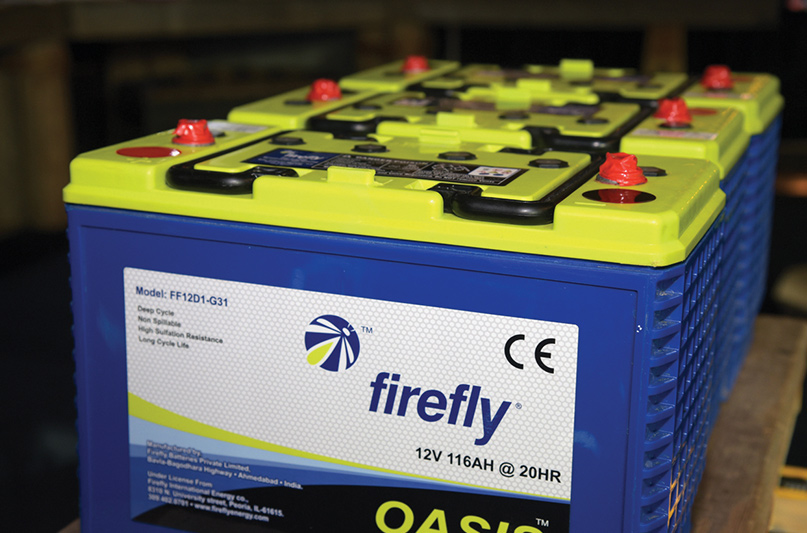The global battery market is estimated to reach $140 billion this year. However, since the introduction of the Absorbed Glass Mat (AGM) sealed or valve-regulated lead-acid battery, we have not seen a considerable shift in battery technology for the marine industry until just recently.
There has been a definite buzz on the docks about the benefits of the proven Firefly Oasis carbon foam AGM battery. It is an almost perfect storm of battery technology meeting the requirements of several different functions across a myriad of applications.
The Firefly Oasis carbon foam AGM battery was developed by Caterpillar to replace the lead-acid batteries used in their work vehicles. Caterpillar found the old battery technology could not, consistently, withstand constant vibration, inconsistent charging, or long periods without charging. This new technology is based on the sealed valve-regulated design of a conventional lead-acid battery but the negative plate has been replaced by a light-weight, sulfation-resistant, microcell material.
The number one reason that boat batteries fail is that the batteries are not regularly charged to completion. The microcell material gives the battery a higher density, allowing it to accept and disperse power faster. The Firefly can deliver 80% of usable battery capacity (depth of discharge or DOD to 20%) and still offer three to four times the battery life of a standard AGM.
For boaters, one of the most significant benefits of this technology is that the battery can be left in a partial state of discharge (i.e., extended cruising, sitting on a trailer or at a dock without power) and it will not lose any permanent capacity. You simply charge the battery, and it will return to 100% of its original capacity.
Boaters are taking more and more land-based comforts on the water, so they are looking for more power, in less space, with less weight. In many cases, there is not enough room to add more batteries, so boaters are looking for an increase in usable battery capacity with a much faster ability to charge.

When a boat has no space for additional batteries, we often recommend upgrading from flooded lead-acid to AGM lead-acid. More usable battery capacity with AGMs can translate to increased battery capacity if you keep the same number of batteries, or you can reduce the battery bank size and still have the same amount of usable capacity. For example, four Group 31 AGMs will provide about the same usable amp-hours as six Group 31 flooded lead-acid batteries.
Only three Firefly Oasis Group 31 batteries provide the same usable capacity as six Group 31 flooded leaded batteries. To top it off, the battery life cycled to 20% DOD would be three to four times that of a flooded lead-acid battery cycled to 50% DOD.
There are a few things to remember if you are going to change the battery chemistry on your boat, especially if you are switching from flooded lead-acid to AGM lead-acid. The profiles must be adjusted on your battery charger, external regulator, battery monitor, and solar controllers. Some of the newer chargers offer a programmable mode that allows you to enter specific voltages. In a 12-VDC battery bank, you will want to charge the Firefly to 14.4 VDC for the target absorption voltage and 13.4 VDC for the float phase.
In terms of cost, flooded lead-acid batteries will always have the lowest upfront price tag, but you have to factor in the maintenance of consistently topping up the fluid levels, the inability to always discharge below 50% DOD, the need for a battery box to contain the liquid electrolyte, and the low amount of cycles. Even if you are super conscientious, a flooded lead-acid battery will only give you 300 cycles at 50% DOD, whereas a carbon foam battery will provide you with 3,600 cycles at 50% DOD for the Group 31 and 4,900 cycles at 50% DOD for the L15+ Firefly batteries.
If you have been contemplating replacing your battery bank, these new batteries make sense. Although the upfront cost is significant, the value proposition is unbeatable because of the combination of increased depth of discharge, faster charging, and the ability to leave the battery in a partial state of discharge (either on purpose or by mistake) and never lose any capacity. It is quite possible that this could be the last battery you buy for your boat.